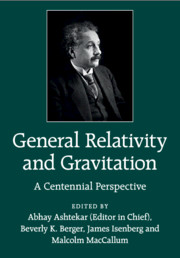Part Four - Beyond Einstein
Published online by Cambridge University Press: 05 June 2015
Summary
Introduction
The remarkable advances summarized in the first three parts of this volume refer almost entirely to the well-established realm of classical general relativity (GR). However, Einstein [1] was quite aware of the limitations of his theory. In the context of cosmology he wrote, as early as in 1945,
“One may not assume the validity of field equations at very high density of field and matter and one may not conclude that the beginning of the expansion should be a singularity in the mathematical sense.”
By now, we know that classical physics cannot always be trusted even in the astronomical world because quantum phenomena are not limited just to tiny, microscopic systems. For example, neutron stars owe their very existence to a quintessentially quantum effect: the Fermi degeneracy pressure. At the nuclear density of ∼ 1015 g/cm3 encountered in neutron stars, this pressure becomes strong enough to counterbalance the mighty gravitational pull and halt the collapse. The Planck density is some eighty orders of magnitude higher! Astonishing as the reach of GR is, it cannot be stretched into the Planck regime; here one needs a grander theory that unifies the principles underlying both general relativity and quantum physics.
Early developments
Serious attempts at constructing such a theory date back to the 1930s with papers on the quantization of the linearized gravitational field by Rosenfeld [2] and Bronstein [3]. Bronstein's papers are particularly prescient in that he gave a formulation in terms of the electric and magnetic parts of the Weyl tensor and his equations have been periodically rediscovered all the way to 2002 [4]! Analysis of interactions between gravitons began only in the 1960s when Feynman extended his calculational tools from QED to general relativity [5]. Soon after, DeWitt completed this analysis by systematically formulating the Feynman rules for calculating the scattering amplitudes among gravitons and between gravitons and matter quanta.
- Type
- Chapter
- Information
- General Relativity and GravitationA Centennial Perspective, pp. 499 - 512Publisher: Cambridge University PressPrint publication year: 2015

